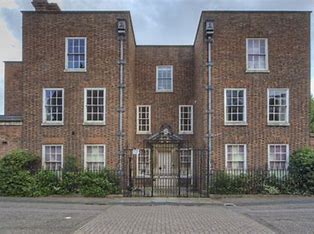Belgrave in the early eighteenth century was a small village near, but not, as now, part of Leicester. The Soar was bridged here, and important roads ran through and near it, but it was a quiet little place. It was here that, in the reign of Queen Anne, Edmund Cradock and his wife Anne built the house we know as Belgrave Hall. It was essentially a middle-class dwelling, plain and unpretentious, with a passing tribute to the prevailing classical style of larger houses in the broken pediment over the front door. But with its Flemish bond brickwork patterned with red stretchers and blue-black headers, splendid wrought iron gates (over which Cradock’s monogram “EC” appears) and lead rainwater heads bearing his crest and full coat of arms; it was an attractive place. Cradock also had the building dates, 1709 and 1713, put on the leadwork, indicating an unusually long period for the erection of a structure of no great size. This may have been brought about by a change of plan during the actual building operations, for there are indications of such alterations in the brick-work, especially on the south side of the house. A modification of this nature could also explain some puzzling features, such as the position of the kitchen and the staircase, and the fenestration of the top floor.
By 1715 the first owners were dead, and the house passed out of the family. After a period during which the Hall acquired (in 1721) an extensive front garden, now the public park opposite, it came into the possession of the Vann family (1767), whose head, William Vann, was a local celebrity, holding the office of High Sheriff for the county. This post was also held by his brother James, the death of whose widow in 1844 ended the Vann connection with the Hall. It was William who built, in 1776, the handsome Adam-style Belgrave House, on the other side of Church Road, removing there himself and leaving the Hall to his brothers.
The Vanns were succeeded by the Ellis family, John Ellis, a Ouaker farmer turned industrialist, completing the purchase of the estate in 1847. Ellis was one of the outstanding figures of the transport revolution of the nineteenth century; a leading promoter of the Leicester & Swannington Railway, first of its kind in the Midlands, he also played an important part in the building of every railway in Leicestershire save one down to the time of his death in 1862, and was chairman of the great Midland Railway at the most critical period of its history.
After his death, his seven daughters continued to live at the Hall until the last died in 1923. Their successor, Thomas Morley, was the last private owner of the house; in 1936 it was acquired by Leicester Corporation for preservation as a museum to illustrate life in a moderately well-to-do household in the eighteenth and early nineteenth century.
(© Leicester Museums Text:Philip A. Stevens, research: Mary Ball).
Currently the house is no longer a museum, but the gardens to the rear are still free to visit (in summer only). Visitors planning to visit the Hall should check on the City Council website for opening times https://www.leicestermuseums.org/belgrave-hall/
Belgrave House

